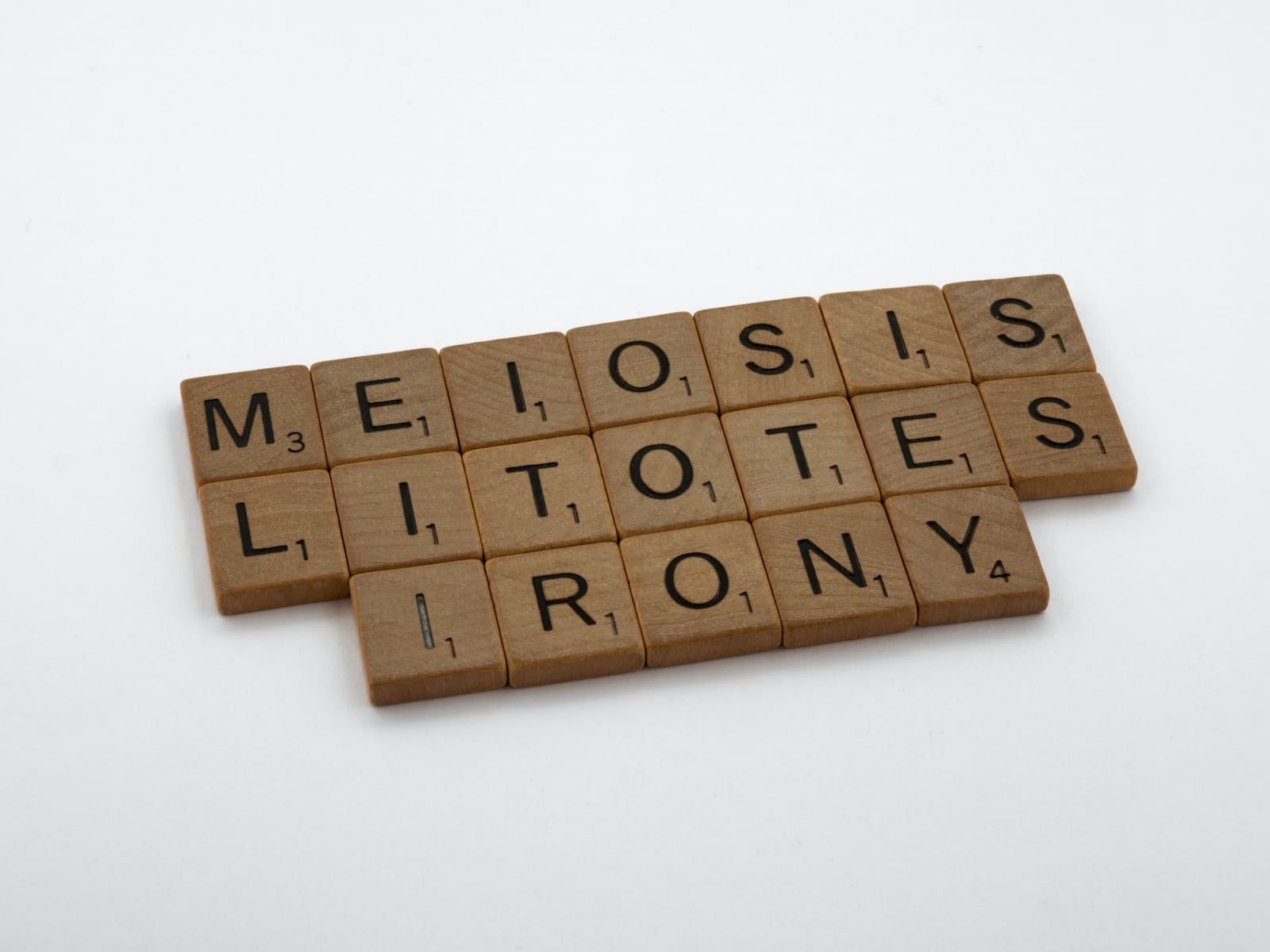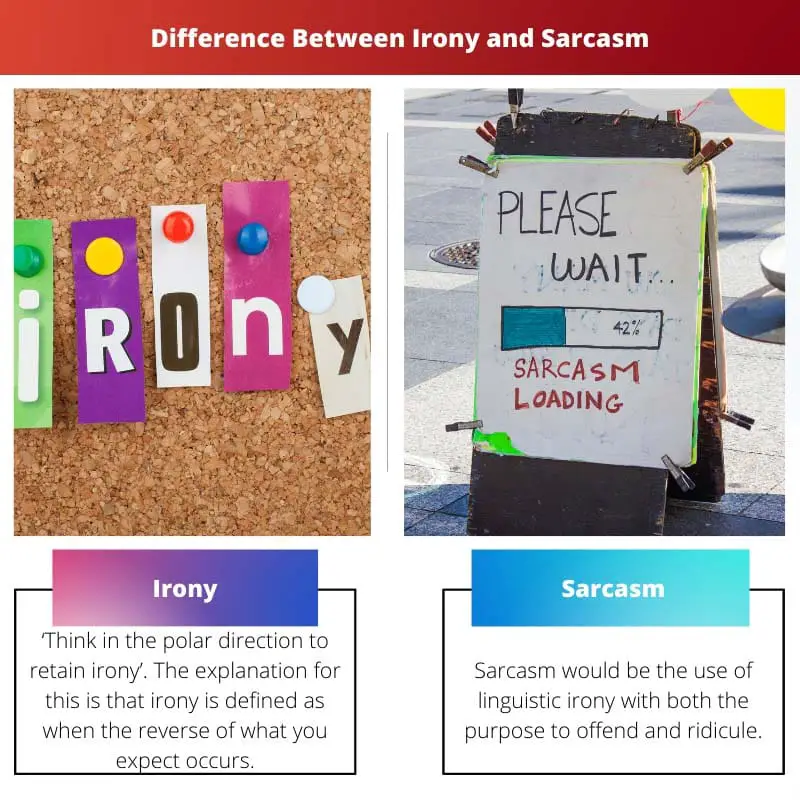Irony is the unexpected twist of events, like a fire station burning down. Sarcasm, on the other hand, involves mocking or conveying contempt through witty remarks, with a tone opposite to the intended meaning. So, while irony is like rain on your wedding day, sarcasm is saying, “Nice job!” when someone spills coffee.
Key Takeaways
- Irony is a figure of speech where words convey a meaning opposite to their literal meaning. At the same time, sarcasm is a form of irony that uses sharp, cutting language to mock or ridicule.
- Irony can be verbal, situational, or dramatic, while sarcasm is a form of verbal irony.
- Irony can be subtle and unintentional, while sarcasm involves intentional, biting remarks.
Irony vs Sarcasm
Irony is a figure of speech in which the intended meaning contradicts what is spoken. Sarcasm is a form of irony in which words are purposely used that are inconsistent or opposite to their intended meaning in order to mock or condemn someone or something.

In its widest meaning, irony is a rhetorical flourish, literary method, or incident in which something appears to be the situation or to be anticipated on the exterior contrasts dramatically from what is truly the case.
Irony is classified into three types: linguistic irony, situational irony, and dramatic irony. Linguistic, dramatic, and situational irony are frequently utilized for prominence in the proclamation of a fact.
Sarcasm is a sort of linguistic irony, but it is much more offensive and irritating. While the terms are frequently used interchangeably, there is a subtle but significant distinction between irony as well as sarcasm.
In a nutshell, linguistic irony occurs when you say something that contradicts what you truly intend.
Comparison Table
| Feature | Irony | Sarcasm |
|---|---|---|
| Type of Speech | Figurative | Figurative |
| Meaning | Opposite of literal meaning | Mocking/Insulting, hidden opposite meaning |
| Intent | Not necessarily intentional, can be situational | Intentional, meant to express negativity |
| Tone | Can be humorous, dramatic, or neutral | Bitter, mocking, dismissive |
| Example | A fire station burns down. (Situational irony) | “Nice work, Einstein!” (Someone makes a mistake) |
| Frequency | More common in literature, plays, and everyday situations | More common in spoken conversations |
| Understanding | Requires context and interpretation | Usually clear due to tone and delivery |
| Effect | Can be surprising, thought-provoking, or amusing | Can be hurtful, offensive, or humorous |
What is Irony?
Irony is a literary device or rhetorical technique in which there is a discrepancy between what is said or expected and what actually occurs. It is a nuanced form of expression that adds depth and layers of meaning to language. Irony is used to highlight contradictions, incongruities, or the gap between appearance and reality.
Types of Irony
- Verbal Irony:
- Involves a contrast between what is said and what is meant.
- Example: Saying “What a beautiful day” during a thunderstorm.
- Dramatic Irony:
- Occurs when the audience knows something that the characters in a story do not.
- Example: In a play, the audience knows a character’s hidden agenda, but the other characters remain unaware.
- Situational Irony:
- Arises when there is a contrast between what is expected to happen and what actually happens.
- Example: A fire station burning down.
Function of Irony
- Enhances Narrative Depth:
- Irony adds complexity to storytelling by introducing unexpected twists and turns.
- Engages the Audience:
- The audience or readers are prompted to think beyond the literal meaning, fostering active engagement.
- Critical Commentary:
- Often used to comment on societal norms, human behavior, or the unpredictability of life.
- Humor and Satire:
- Irony is a powerful tool in humor and satire, allowing for clever commentary or ridicule.
Examples of Irony in Literature
- Shakespeare’s “Romeo and Juliet”:
- The audience knows that Juliet is not truly dead, but Romeo, unaware of the plan, believes she is and takes his own life.
- O. Henry’s “The Gift of the Magi”:
- The characters’ selfless acts of sacrifice for each other result in ironic consequences, as their gifts become unusable.

What is Sarcasm?
Sarcasm is a form of verbal irony where someone says something but means the opposite, to mock or convey disdain. It relies on the tone of voice, context, and the relationship between the speaker and the audience.
In essence, sarcasm is a deliberate expression of contempt or ridicule through clever or cutting remarks. It involves stating the obvious in a way that highlights its absurdity, with the intention of humorously criticizing or belittling a person, situation, or idea.
The effectiveness of sarcasm lies in its subtlety and the expectation that listeners will recognize the disparity between the literal meaning of the words spoken and the intended sarcastic meaning. It can serve as a form of social commentary, humor, or a defense mechanism, depending on the context and the dynamics of the conversation.

Main Differences Between Irony and Sarcasm
- Definition:
- Irony: Involves a situation where there is a discrepancy between expectations and reality, with a surprising or unexpected outcome.
- Sarcasm: A form of verbal irony where someone says something but means the opposite, with the intent to mock or convey contempt.
- Intent:
- Irony: Primarily focused on highlighting contrasts or incongruities without necessarily intending to mock or criticize.
- Sarcasm: Intentionally employs irony as a tool to mock, criticize, or express disdain.
- Tone:
- Irony: Tone may vary, and it doesn’t always carry a negative or mocking connotation.
- Sarcasm: Typically characterized by a mocking or contemptuous tone, aimed at ridiculing the subject.
- Form:
- Irony: Can manifest in various forms, including situational irony, dramatic irony, and verbal irony (which can include sarcasm).
- Sarcasm: Primarily a form of verbal irony, relying on spoken language to convey the intended meaning.
- Usage:
- Irony: Often used to highlight the unexpected or paradoxical nature of events, statements, or situations.
- Sarcasm: Employed as a tool for humor, criticism, or social commentary by using irony in a more direct and pointed manner.




